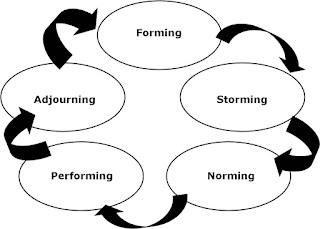How Do You Behave In A Team?
Teams exist to get a task or tasks done – their sole purpose is achieving outcomes. This might seem straightforward enough but not all teams work together well.
The model above on team development and behaviour was developed by Dr Bruce Tuckman in 1965 to help understand what high performing teams need to do in order to achieve their outcome. Adjourning was added in c1975 and recognises that closure is needed to move from performing in one team to forming another team.
So let’s have a look at each stage in detail
Forming
When a group of people come together they are not yet a team. Forming the team, getting the right people in the team and making sure they have the right roles is really crucial if the group is to become a team that achieves its goal.
But that’s not the only time a team forms – when members leave and new members join the team, the team has to go through the same process of welcoming the new member into the team, and showing them how things are done around here!
This is also the stage where the end goal or outcome is discussed for the first time.
So the forming stage occurs when teams come together for the first time or when something changes in the team.
Storming
This is always the interesting stage in team development because it’s about testing the boundaries and ground rules of the team. So you might experience competitiveness among team members and sometimes out and out conflict. Jockeying for position can also accompany this stage in the team development along with game playing and ‘showing off’.
Teams that go on to achieve great things develop a way of managing this conflict so that it becomes a healthy way of airing differences and getting things out in the open so that they can discuss and move on. Trust is a key success factor in whether or not the team will move on.
In dysfunctional teams, they never move beyond this stage usually because there is insufficient trust and lack of shared goal.
So storming is about laying your cards on the table and really getting into the nitty gritty around the shared goal.
Norming
On the surface this sounds pretty bland and inane but it’s surprising how many teams never reach this stage. Having gone through working out each other and getting all the issues on the table a team that can pretty much function day to day without too much hassle has reached a stage of balance and functions well.
They’ve worked out how to get along and all know what their role is within the team and know what tasks they’ve got to achieve. They are also pretty good at decision making through agreement and discussion. BUT there is a danger that if a team stays too long at the ‘norming’ stage there is a danger that complacency will creep in and motivation will wane.
So norming is about finding a balance without becoming complacent.
Performing
This is the stage that all teams want to reach because it’s here they’re getting great results and are working well together. This is the stage when they have become a real team. The challenge at this stage is continuous improvement so that the team can continue to get great results.
Truly brilliant teams know how to add a bit of frisson into the mix so that they constantly challenge the team with new ideas and different perspectives to bolster motivation.
Adjourning
This stage was added later to recognise that teams do not last forever and in an age of constant flow and flux, organisational change is perhaps the only constant. Recognising the team’s achievements both what’s gone well and what could have gone better is part of the letting go process. Without this formal stage of ‘saying goodbye’ forming new teams becomes more challenging.
Adjourning is a way of ‘grieving’ the old team and enabling a new journey with the next team. This is an important part of the process and very often missed in organisations. No wonder people still hark back to the ‘good old days’ when they were in team XYZ!
So there you have it, a simple yet effective model to understand what happens in teams and maybe some pointers as to what might be happening in your team. What have you noticed about how your team works together – and how you behave within the team?
It can help to have a facilitator to help the team become more aware of their behaviour within each stage of the process. A great facilitator helps groups transition into teams.
Tuesday, 15 March 2011
Subscribe to:
Post Comments (Atom)


No comments:
Post a Comment